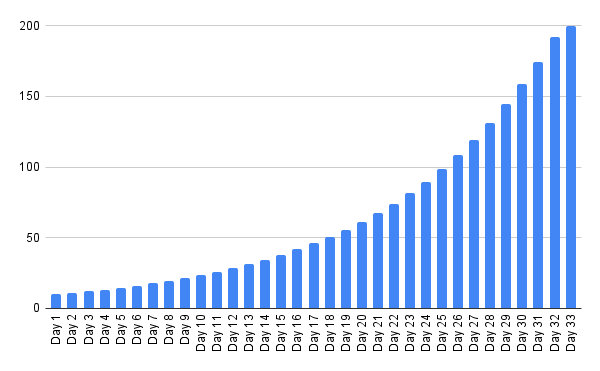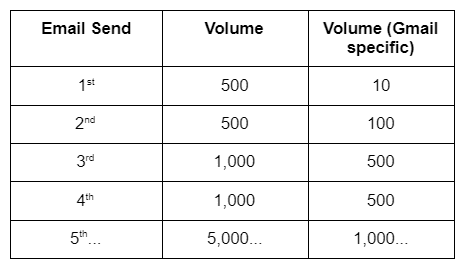What Is an Email Ramp?
An email ramp (or warm up) is a common deliverability best practice that involves sending to a small segment of your most engaged users and then gradually increasing the volume with each subsequent send. Whether you are adding a dedicated IP or switching to a new dedicated IP, we highly recommend an email ramp to maintain or improve email deliverability and ensure consistent inboxing.
While each ISP has their own nuances and algorithms that determine the sending volume a new IP should begin with, there’s a general range that we can apply when sending to most ISP domains. But before we get into that, let’s quickly take a step back to better understand the importance of email ramps and how to implement a successful strategy.
Email Ramp-up is a method used to increase your daily email sending limit over time gradually.
Instead of bombarding your recipients with a ton of emails all at once, you start with a small number and then gradually increase it each day.
This way, you build a positive sending reputation and reduce the risk of being flagged as spam or having your account blocked.
Why Email Ramp-up is so Helpful?
By taking it slow and steady, you establish trust with email providers, making it more likely for your emails to reach the recipient’s inbox.
Email Ramp-up can work wonders in keeping your emails structured and well-received, especially if you’re running mass cold email campaigns with a new domain or email account.
When to Consider Using Email Ramp-up?
Here are some handy guidelines:
- If your domain is fresh and new
- If you send a lot of emails, increase your sending volume slowly
- If you send emails daily, you can ramp up quicker than if you send weekly
- If you send emails only to subscribers, you can increase the sending volume quicker since they have opted-in
During the ramp-up process, keep a close eye on your email analytics and feedback loops to ensure successful delivery and prevent being marked as spam. Remember, building a positive sending reputation takes time, so patience is key.
After you complete the prerequisites, you can begin warming up your sender domain. Warming up is the process of gradually increasing the email volume. When contacts engage with your emails, your sender domain earns a positive reputation. By the end of the warm-up process, your sender domain will be primed and ready to send any email volume you have planned.
Let’s say you start with a sending limit of 10 emails and increase it by 10% daily until it hits 200. Here’s how the magic unfolds:
- Day 1: Send 10 emails
- Day 2: Send 11 emails
- Day 3: Send 12 emails
- Day 4: Send 13 emails
- Day 5: Send 15 emails
- Day 6: Send 16 emails
- Day 7: Send 18 emails and so on…
Or go with this logic:
What’s the logic used behind Email Ramp-up?
We use a percentage increment method here as it is super beneficial.
- The sending limit increases the speed of incrementing the number of emails as the account gets warmup. It is an actual warmup situation.
- It takes lesser days to reach the sending limit.
- The sending pattern looks more random.
Let’s understand the same with an example :
- Set the sending limit at 10 and increase the sending limit by 10% daily until it hits 200.
- 10, 11, 12, 13, 15, 16, 18, 19, 21, 24, 26, 29, 31, 35, 38, 42, 46, 51, 56, 61, 67, 74, 81, 90, 98, 108, 119, 131, 144, 159, 174, 192, 200
- It will take 33 days to reach 200

Gmail Is the Exception to the Rule
As I mentioned above, every ISP has its own set of criteria and rules regarding how many messages should be mailed and to which recipients. In general, these criteria are similar enough that a sender could use a blanket approach as shown in the example above.
Gmail, however, is usually more aggressive with volume constraints during the initial email ramp phase. To put yourself in the best position to succeed when ramping up with Gmail, you should be more conservative and limit sending volume to build your email reputation more quickly.
An example of an email ramp plan with Gmail isolated might look like this:

Final Tips on Email Ramps
- Not all senders are the same. And neither are all email ramps. Contact a team of deliverability experts to help you craft and implement a good email ramp strategy. Act-On’s email deliverability team can provide a manual plan based on your program or institute an automated solution.
- Good things come to those who wait. By definition, an email ramp plan involves starting slow and gradually building up over time. While it’s tempting to send to your entire audience right away, you should start smart for consistent and prolonged success in the future.
- Keep your eyes peeled. Email ramps are rarely perfect, and you’re bound to run into some challenges along the way. So it’s important to monitor performance early and often so that you can distinguish between normal hiccups and larger issues.